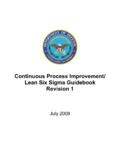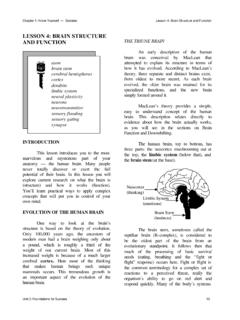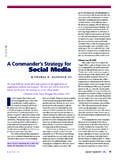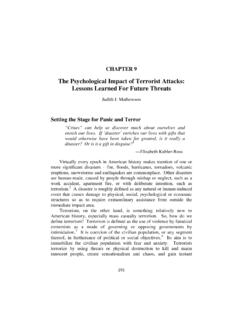Transcription of Chapter 10. Participative Management and …
1 Ch 10 Participative Management Chapter 10. Participative Management and employee and Stakeholder Involvement1 By Kristi M. Branch Participative Management addresses the relationship between the organization and its workers and stakeholders. It addresses fundamental issues of governance within organizations and the role of employees and external stakeholders in all levels of organizational decision making. In addition to philosophical issues of governance and the appropriate relationship between workers and their employers, the literature on Participative Management can help managers dealing with the fundamental challenges facing public science managers in today s dynamic and competitive environment: maintaining high levels of effectiveness, productivity, innovativeness, and worker motivation in an increasingly dynamic, competitive environment.
2 Participative Management is recognized as particularly pertinent to organizations dealing with complex, knowledge-based problems. Extensive research conducted as early as the 1950s and 1960s demonstrated that Participative Management is particularly well suited to science-based organizations whose key staff are noted for their creativity, intrinsic motivation for work that interests them, stronger affiliation with their discipline than their organization, and sensitivity to directive Management (Likert 1969; Marcson 1960; Siepert 1964; Macy 1965; Steele 1969). The interdependence of scientific research, and hence of scientific organizations, requires participation at multiple levels. New requirements to involve external stakeholders in policy-setting and planning decisions, and to address concerns about the public acceptability of research programs place additional demands on the skills and capabilities of both managers and staff.
3 One of the main social and organizational utilities of participation is that it offers the possibility of resolving contradictory interests through individual negotiation and/or collective bargaining rather than imposition of authority (Bolle de Bal 1992a). Overview Since its origins with Elton Mayo s The Human Problems of a Industrial Civilization (1933) and Kurt Lewin s Frontiers in Group Dynamics (1947), a large and diverse literature has been assembled on Participative Management , which includes employee involvement, industrial democracy, and stakeholder involvement. Interest in Participative Management has been persistent during this period, with periodic surges corresponding to the social, political, and economic issues of chronically low productivity in the 1960s and 1970s, and international challenges to industry and product quality in the 1980s and 1990s when worker motivation, productivity and innovativeness became priority issues.
4 Recently, the focus has been on the relationship between Participative Management and the newer, organic and networked organizational forms, dramatically improved information and communication technology, and greater citizen involvement in organizational decision making. The literature reflects a growing recognition among academics and managers that a high productivity/high wage economy requires new labor- Management relationships, including ways to share gains and organize work that more fully develop and utilize the skills, knowledge, and motivation of the workforce 1 Related chapters include: Science Policy; Strategy; Change Management ; Teams and Project- and Program-Based Organizations; Organizational Alliances, Partnerships, and Networks; Organizational Culture; Organizational Communication; Innovation.
5 Ch 10 Participative Management 2 (Commission on the Future of Worker- Management Relations 1995:38). Indeed, Participative Management is increasingly seen as a feasible system of governance for these organizations (Lawler 1996). The literature reflects a wide and diverse research orientation. Social philosophy and organizational theory, human development, Management practices, small-group processes, and leadership perspectives are all represented. It is enriched with a significant comparative component: interest in Participative Management and industrial democracy has also been high in Europe and the Scandinavian countries. This provides a useful check on the ethnocentrism that can occur when the entire literature shares a similar cultural or geopolitical context.
6 Unlike many aspects of the organizational effectiveness and Management literature, both public and private sector organizations have been subject to investigation regarding Participative Management and employee involvement, and there have been some instructive time-series studies on the extent of adoption and the organizational consequences of Participative Management practices (Lawler et al. 1986, 1992, 1998, 2001). In addition, there is a strong body of research on the relationships among aspects of organizational design, Management practices, and worker characteristics pertinent to Participative Management and employee involvement. In keeping with the general problem-driven nature of the organizational effectiveness literature as a whole, the literature on Participative Management has tended to focus on production-oriented or service-providing organizations where issues of worker motivation and satisfaction, product and service quality and productivity were most acute.
7 However, research on the Management of science has included attention to the pertinence of Participative Management for both public and private research organizations. The literature on external stakeholder or citizen participation, which has also included some specific attention to science-based organizations, is essentially separate from that on Participative Management and employee involvement. The Organizational Context: Why The Interest in Participative Management Now? Competitive Pressure The literature on Participative Management and employee involvement addresses the interactive relationship between the broader socio-political system and the workplace, in both empirical and philosophical or normative terms, and then tiers that examination down to look at the relationships between organizational design, managerial approach, workplace conditions, job design, pay systems, worker and manager characteristics, organizational performance, and worker and manager motivation and satisfaction.
8 As a consequence, the literature spans discussions of social theory, organizational theory, human relations and organizational psychology, and Management strategies and approach. It draws upon a variety of theoretical frameworks and models about the purposes and mechanisms for achieving participation and the impact of participation on the organization and its members. A key factor in the interest in Participative Management was the realization, which really struck home during the 1980s, that better Management practices -- superior quality Management systems, better employee relations, integrated design and production teams -- could provide critical competitive advantages to public and private sector organizations (Lawler 1996).
9 During this same period, heightened issues about the societal accountability of organizations also occupied Management attention (Collins 1997). As a result, since the 1980s there has been substantial expansion in the number and variety of employee participation efforts and initiatives Ch 10 Participative Management 3 and the number of organizations employing Participative Management strategies, although these practices still remain only partially diffused throughout the economy (Commission on the Future of Worker- Management Relations 1995). Underlying the entire discussion of Participative Management and employee and stakeholder involvement is the dominance of the bureaucratic, hierarchical organization model and Management approach commonly referred to as Taylorism (based on Frederick Winslow Taylor s 1911 classic The Principles of Scientific Management ) or Fordism (based on the principles developed by Henry Ford).
10 However, the pre-eminence of the bureaucratic, hierarchical organization model and traditional Management practices is facing increased challenge (Lawler et al. 2001). In the early literature, Participative Management strategies and employee and stakeholder involvement were approached as modifications of or supplements to the traditional bureaucratic, hierarchical model, undertaken to achieve particular goals or address particular problems. Recently, however, Participative Management has been discussed as a comprehensive governance system that could, and is, replacing the traditional bureaucratic hierarchical system for the new, organic, networked organizational forms emerging in the late 1990s. Conversion into a Participative organization is seen as a way for an organization to build key capabilities essential for success in the complicated and dynamic contemporary organizational environment (McLagan and Nel 1995; Bartlett and Ghoshal 1991; Case 1998).









